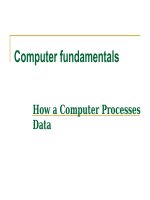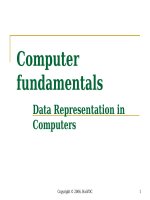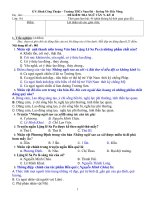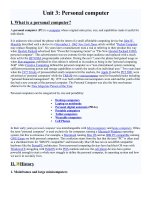Computer Interfacing (1)x
Bạn đang xem bản rút gọn của tài liệu. Xem và tải ngay bản đầy đủ của tài liệu tại đây (1.34 MB, 109 trang )
Computer Interfacing
1
Interfaces and Interfacing
. Definitions of “interface” from Webster’s Dictionary:
. noun: the place at which independent systems meet and act or
communicate with each other
Examples:
human - machine interface (analogue-machine interface), terminal - network
interface (TTL - CMOS interface), parallel or serial interface
. Informal Definition
i) The physical, electrical and logical means of exchanging Information
with a functional module
ii) The process of enabling a computer to communicate with the
external world through Software, Hardware and Protocols
2
. An interface is a device and/or set of rules to match the output of one device
to send information to the input of another device
. physical connection
. the hardware
. rules and procedures
. the software
. Interfacing is the process of connecting devices together so that they can
exchange information
. The process of reading input signals and sending output
signals is called I/O
. I/O conventions
. I/O direction is relative to the MCU
. Input is data read by the MCU
. Output is data sent out by the MCU
3
Interfaces and Interfacing
A microcontroller (sometimes abbreviated µC, uC or MCU)
Why is computer interfacing important ?
1. The human - machine interface determines the ultimate
success or failure of many computer- based systems
2. Digital systems exist within and must successfully interact with
an analogue natural environment (Digital – analogue interfaces
are unavoidable)
3. Rather than designing digital systems from elementary
components, computer engineers more typically assemble new
systems from existing subsystems
4
Typical Interfacing Activities
. Selecting software/hardware subsystems that can (at least potentially) interact well with each other
. Appropriate D/A and A/D converters (speed, accuracy, .)
. Serial vs. parallel communication
. Providing appropriate hardware connections
. Selecting cabling, connectors, drivers, receivers, correct termination, etc.
. Resolving any hardware incompatibilities
. CMOS with TTL
. Configuring hardware interfaces correctly using low-level
software drivers
. LCD, Keypads in embedded systems (Liquid Crystal Display-LCD)
. Interfacing software components correctly
. Selecting compatible software versions
. Calling the correct procedures in the correct sequence with the correct
parameters
5
6
SERIAL COMMUNICATION
Typical Interfacing Activities
PARALLEL COMMUNICATION
Connectors
Transducer and receiver
What is Termination?
Termination, in its most basic sense, is the connection of a cable to a source or destination
device. For low frequency applications, this may involve simply putting the individual wires in a
connector and attaching the connector to the device.
At higher frequencies, termination can also take a second meaning. To first understand
termination you need to understand impedance.
In many systems, such as Broadband/CATV or broadcast video, signals are split to go in different
directions. Each of the splits (outputs) must "see" the correct impedance. Normally, one would
simply attach a cable of the correct impedance to each of the outputs of the device.
But it can sometimes happen that there are more splits than desired. In that case, those unused
outputs must be "terminated" with the correct impedance. To accomplish this, you attach a
connector which contains a resistor inside chosen to mimic the correct impedance. In other
words, you fool that output into thinking a cable is attached, when in fact, there is none!
If you do not terminate unused outputs, they can radiate, and that signal can cause noise and
interference in other nearby equipment.
7
Typical Interfacing Activities
For RF applications, or for extremely long signal runs, such as telephone circuits, impedance matching is essential. Matched
impedances mean that the source, cable and load impedances are all the same.
•
CMOS with TTL
Complementary metal–oxide–semiconductor (CMOS) is a technology for constructing integrated
circuits
Transistor–transistor logic (TTL) is a class of digital circuits built from bipolar junction
transistors (BJT) and resistors
8
Typical Interfacing Activities
•
CMOS with TTL
9
Typical Interfacing Activities
•
CMOS with TTL
10
Typical Interfacing Activities
•
CMOS with TTL
11
Typical Interfacing Activities
System-Level Interfaces
Human-machine interface
. Input devices: keyboard, mouse, microphone, camera
. Output devices: CRT, printer, light panel, audio amp
12
Cathode Ray Tube (CRT)
Digital - Analogue Interface
. Input devices: A/D converters, modems, sensors
. Output devices: D/A converters, modems, transducers
actuators, stepper motors
. Control devices: switches, multiplexers, amplifiers
Attenuators
Digital - Digital Interface
. Connectors: wires, ribbon cable, coax, twisted pair, PCB
. I/O devices: buffers, level-shifters, synchronizers
13
System-Level Interfaces
Printed Circuit Board-PCB
ribbon cable
coax
twisted pair PCB
level-shifters
This great tiny board will
allow to interface slave
3.3V I2C devices like
magnetometers and
pressure sensors with
master 5V devices like
AVR/PIC microcontrollers
A synchronous circuit is a digital circuit in which the parts are synchronized by a clock signal
An asynchronous circuit, or self-timed circuit, is a digital circuit which is not governed by a clock circuit or global clock signal
Hardware Interfaces within a Personal
Computer (PC)
14
Components of a Computer System
15
Introduction to Microcontroller
Embedded System
. You are used to chips like the Pentium, but in terms of installed machines these are a small portion of total
computer use.
Think how many computers you have at home?
. Digital cameras, video cameras, TVs, mobile phones, calculators, micro-wave ovens etc all contain
processors. In order for a microprocessor to be used, other components such as memory, or components for
receiving and sending data must be added to it.
. On the other hand, microcontroller is designed to be all of that in one.
. No other external components are needed for its application because all necessary peripherals are already
built into it.
. Thus, we save the time and space needed to construct devices.
. The PICmicro was originally designed around 1980 by General Instrument as a small, fast, inexpensive
embedded microcontroller with strong I/O capabilities.
16
Characteristics of Embedded System
. Embedded computers have to be very low cost, simple and
reliable.
. They can not use any moving parts (disk drives) because:
1. power hungry
2. bulky
3. expensive
17
Features of Embedded System
. Program in Read Only Memory ROM
. Limited RAM storage variables only not code
. Built in I/O devices
. Use very little power
Embedded System General Block Diagram
18
Microcontroller
. Microcontrollers, as the name suggests, are small controllers
. They are like single chip computers that are often embedded into other systems to
function as processing/controlling unit
. For example, the remote control you are using probably has
microcontrollers inside that do decoding and other controlling functions
. They are also used in automobiles, washing machines, microwave ovens, toys ... etc, where
automation is needed
. The key features of microcontrollers include:
. High Integration of Functionality
. Microcontrollers sometimes are called single-chip computers because they have on-chip
memory and I/O circuitry and other circuitries that enable them to function as small standalone
computers without other supporting circuitry
19
Microcontroller
.The key features of microcontrollers include:
. High Integration of Functionality
. Microcontrollers sometimes are called single-chip computers because they have on-chip memory and I/O circuitry and other
circuitries that enable them to function as small standalone computers without other supporting circuitry
. Field Programmability, Flexibility
. Microcontrollers often use EEPROM or EPROM as their storage device to allow field programmability so they are flexible to use
. Once the program is tested to be correct then large quantities of microcontrollers can be programmed to be used in embedded
systems
. Easy to Use
. Assembly language is often used in microcontrollers and since they usually follow a RISC architecture, the instruction set is small
. The development package of microcontrollers often includes an assembler, a simulator, a programmer to "burn" the chip and a
demonstration board
. Some packages include a high level language compiler such as a C compiler and more sophisticated libraries
20
Microcontroller, Microprocessor and Microcomputer
. A microcontrollers are is like a single chip computers that are often
embedded into other systems to function as processing/controlling unit
Microcontrollers are used in a wide number of electronic systems such as:
. Engine management systems in automobiles
. Keyboard of a PC
. Electronic measurement instruments (such as digital multimeters, frequency synthesisers, and
oscilloscopes)
. A microprocessor is a programmable digital electronic component that
incorporates the functions of a central processing unit (CPU) into a single IC
package
These functions are
. The ability to execute a stored set of instructions to carry out user defined tasks
. The ability to be able to access external memory chips to both read and write data from and to the
memory
21
. Types of Memory can be obtained as either:
. Read Only Memory (ROM)
. This is memory that can only be read, the data being stored in the memory device during its manufacture
. Once data has been written onto ROM memory, it cannot be easily removed and is designed for 'read only' use
. ROM is referred to as being non-volatile as it retains its contents even when the power is turned off
. Erasable Programmable Read Only Memory (EPROM)
. This is similar to ROM type memory but the user can program it
. The contents of the memory can be erased from the memory by exposing the memory chip to ultraviolet
radiation for a short period of time
. It can therefore be used many times over
. Electrically Erasable Programmable Read Only Memory (EEPROM)
. Similar to EPROM but has part or all of the memory contents erased by the microprocessor
22
Microcontroller, Microprocessor and Microcomputer
. Both ROM and EPROM memory are used to hold the program
code of a microprocessor used in an embedded system, ie. a
microprocessor used in an application where the program code is always the same
and is designed to execute every time the system is switched on
. Most development work is done using EPROM or EEPROM type
memory, ROM memory being used in the final production version (when all the
program code has been fully tested)
. Random Access Memory (RAM)
. All microprocessor systems need memory that can be both read from and
written to - such memory is RAM
. RAM got its name because early read-write memories were sequential, and
did not allow random access. RAM memory is used to store dynamic data (that will
change during the operation of the program)
23
Microcontroller, Microprocessor and Microcomputer
. RAM takes the form of integrated circuits that allow the stored data to be
accessed in ANY order . That is, at random and without the physical movement
of the storage medium or a physical reading head
. The word "random" infers that any piece of data can be returned quickly, and
in a constant time, regardless of its actual physical location, in relation to the
previous data storage location
. The key benefit of RAM is that retrieval times are short and consistent. The
disadvantages of RAM are cost, and the loss of data when power is turned off
(volatile).
. A typical microprocessor system will contain both ROM (could be EPROM,
EEPROM, or ROM) to store the program code, and RAM to store dynamic
data
24
Microcontroller, Microprocessor and Microcomputer
Input/Output (I/O)
. I/O (input/output) is the collection of interfaces that different functional
devices, of any information processing system, use to communicate with
each other
. Every information transfer is an output from one device and an input into
another
. For instance, on a computer, a keyboard and mouse are considered input
devices while monitors and printers are considered output devices
. Typical devices for communication between computers, such as modems
and network cards, operate as both input and output devices
. I/O can be:
. A number of digital bits formed into a number of digital inputs or outputs called a port
. These are usually eight bits wide and thus referred to as a BYTE wide port. i.e. byte wide input port, byte
wide output port
25









